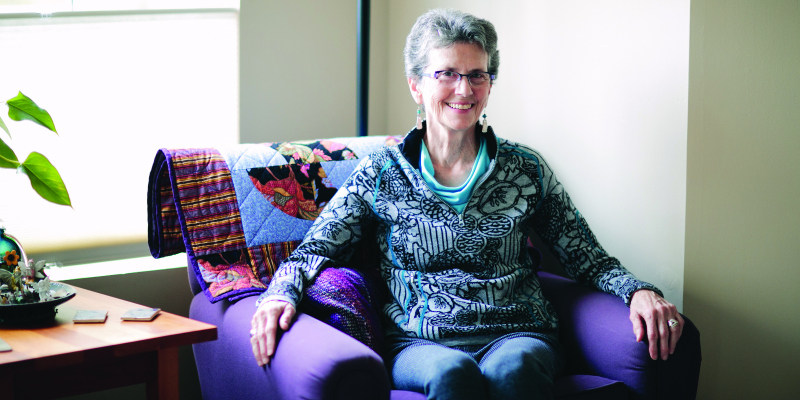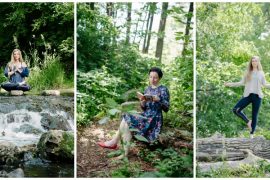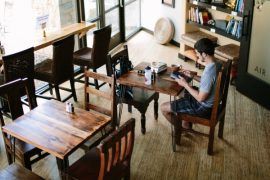Facing the struggle, finding solutions: Madison-area women confronting Alzheimer’s Disease
By Lisa Bauer | Photographed by Kaia Calhoun
After 30 years in corporate training, Jane Ellen Donovan began finding it difficult to understand basic conversations. She often couldn’t find her keys or purse or do simple tasks at home. The first doctor she saw said it was just a part of getting older, but she knew something was wrong.
She switched to UW Health for tests in November 2016. “They showed me my brain scan, and I saw all kinds of beautiful colors on the left side,” she says, “but you don’t want that. It was Alzheimer’s.”
Donovan, 68, decided to sell her home and move into a retirement center. She and her children are considering a future for her at Attic Angels as the disease progresses. An avid reader who loved book clubs, she can now only read children’s books. A social butterfly, she’s lost friends who have a hard time understanding her disease. She has a chef for seniors cook for her. She’s driving less and less.
But Donovan is youthful, spry and determined. She’s an advocate and activist. “How do I keep positive? That’s just who I am,” says Donovan, smiling. “I want to be with people, listen to people, learn things from people, as long as I can.”
There is no cure for Alzheimer’s, a degenerative brain disease and the most common form of dementia. According to the Alzheimer’s Association, more than five million Americans are living with the disease. By 2050 this number could rise to 16 million. Women get Alzheimer’s more often than men. African-Americans are twice as susceptible, and Latinos are 1.5 times more likely to get the disease. One in three seniors dies with Alzheimer’s or another dementia. Alzheimer’s kills more people than breast and prostrate cancer combined. In Wisconsin, the disease took 2,085 lives in 2016.
Alzheimer’s can start with symptoms of dementia such as difficulties with memory, language and problem solving that affect the ability to perform everyday activities. It’s not just forgetting your keys. As more nerve cells in the brain are damaged and destroyed, you can’t carry out basic bodily movements and functions, such as walking and swallowing. People in the final stages require round-the-clock care.
Alzheimer’s is one of the most expensive diseases in America. According to the Alzheimer’s Association, in 2017, Alzheimer’s and other dementias will cost the nation $259 billion and is expected to reach a staggering $1.1 trillion by 2050.
“We are doing what we can to end Alzheimer’s,” says Jane Mahoney, director of UW’s Wisconsin Alzheimer’s Institute. “We need research, we need to educate people and we need to understand health disparities. On a community level, we need to make sure people with dementia are not separated from their communities. But with the work that is going on nationally and internationally, we’re optimistic and beginning to ask the question, ‘When will we have the first survivor?’”
UW: A HUB FOR ALZHEIMER’S RESEARCH AND SUPPORT
We don’t know what causes Alzheimer’s, why it progresses at different rates and how to treat, prevent, slow or cure it. Pioneering scientists at the University of Wisconsin are racing to find answers.
“What we’re doing is unique and recognized,” says Mahoney. UW has two main centers studying the disease—the Wisconsin Alzheimer’s Institute and the Wisconsin Alzheimer’s Disease Research Center. “In the last five years we’ve seen a sea change in research. It may take 15 or 20 years, but we are optimistic we can find treatments and a cure.”
Scientists are honing in on plaques and tangles in the brain as prime suspects in causing Alzheimer’s. Amyloid protein builds up and clumps together between cells causing plaques, while Tau protein builds up inside cells creating tangles. These two abnormalities wreak havoc. (Take a tour to learn how Alzheimer’s affects the brain at alz.org/brain.)
“We weren’t even able to see plaques and tangles in brain scans until the last decade,” Mahoney says. Often once symptoms occur, plaques and tangles may have been doing damage for a decade or more. Finding evidence of these culprits early is key as treatments come down the pike.
Along with brain imaging, UW scientists like Barbara Bendlin are analyzing proteins in fluids around the brain and studying loss of brain connections. Research is done on adults who get annual exams, imaging and lumbar punctures. “A big part of this story is the super committed volunteers involved,” Bendlin says.
The world’s largest longitudinal research study on adults with parents who were diagnosed with Alzheimer’s disease is at the institute: the Wisconsin Registry for Alzheimer’s, or WRAP. Scientists have followed 1,550 people for 16 years to study biological, health and lifestyles factors that affect the disease. The study, funded by the National Institutes of Health, aims to identify Alzheimer’s early and uncover risk factors.
“One of the most interesting things we found is regarding insulin resistance,” Bendlin says “Blood glucose and insulin levels are related to brain changes. This doesn’t mean diabetes causes Alzheimer’s, but there’s a possible link.” They’ve also found that people reporting poor sleep showed evidence of plaques and tangles. There may also be a relationship between microbial gut bacteria and the brain. Exercise and healthy eating seem to be associated with brain benefits.
“We don’t want to say you get Alzheimer’s if you don’t exercise or follow a healthy diet,” she says, “but it may be that lifestyle changes in mid-life could help delay the onset of Alzheimer’s.” She suggests people explore the MIND Diet, which focuses on foods that are healthy for the brain, or the Mediterranean diets.
Friends and family may even decrease your risk. As Bendlin says, “Even if you’re developing plaques and tangles, if you have a higher level of networking with people, it can be protective of cognitive function.”
Other research has shown connections between Alzheimer’s and cardiovascular disease, fewer years of formal education, lack of social and cognitive engagement, traumatic brain injury and excess tobacco and alcohol use. UW’s Amy Kind is studying how living in a disadvantaged neighborhood—one with substandard housing, poverty, low education and high unemployment—impacts Alzheimer’s risk. Age, family history and genetics also come into play.
There’s no single test for Alzheimer’s disease. Treatments focus on alleviating symptoms and improving quality of life. Medications may help lessen memory loss and confusion, for a limited time. Doctors also use memory training, light therapy, exercise, cognitive stimulation and music.
Wisconsin scientists—many of them women—lead the way in Alzheimer’s research (visit bravamagazine.com to read “The Science”), and the state is also pioneering in its clinical support for Alzheimer’s patients and their families. A pillar program at the Alzheimer’s Institute is 31 innovative memory clinics across Wisconsin that offer state of the art diagnostic, treatment and social services to more than 3,000 new patients annually, many from rural, underserved parts of the state.
“The science is advancing very quickly,” says Bendlin, “We have a greater understanding of Alzheimer’s, new advances in technology and people working in a lot of different fields to bring novel insight to a huge problem.”
FIND LOCAL SUPPORT
ALZHEIMER’S ASSOCIATION SOUTH CENTRAL WISCONSIN CHAPTER
Kari Paterson, executive director, says 120,000 people suffer from Alzheimer’s in the state of Wisconsin with 7,000 in Dane County. These numbers—and those nationwide—are expected to triple in 15 to 20 years.
The Alzheimer’s Association—with 80 chapters across the country—works globally, nationally and locally to eliminate the disease. It can provide care and support to those affected by Alzheimer’s, advocate for research, prevention and care initiatives at the state and federal level and raise awareness and educate. The Association is the largest nonprofit funder of Alzheimer’s research in the world.
Each year it publishes a hefty “facts and figures” report to bring the latest research, updates and data to the forefront.
“I get pumped up seeing families that have benefitted from our education and support. And I get excited thinking about the momentum of research in our state and across the world,” Paterson says. “I hope we find a game changer in the next few years.”
Join the Association’s local Walk to End Alzheimer’s fundraiser each fall. Go to alz.org for more information.
ALZHEIMER’S AND DEMENTIA ALLIANCE OF WISCONSIN
In 2009, the Alzheimer’s Alliance began as a grassroots effort to serve families in south central Wisconsin.
Kristin Larson, of the Alliance, says its focus is to “support people at any and every stage,” from diagnosis to end-of-life care. The Alliance focuses on rural areas that don’t have access to care. They provide support specialists who help with diagnosis, accessing resources, working with challenges and planning for care needs.
The Alliance also offers programs for those with Alzheimer’s and their caregivers, including “memory cafes,” social gathering places for people with early Alzheimer’s or other dementia and their family and friends.
“We firmly believe this is a disease that people should not address alone,” Larson says. “We’re here to make the journey a little easier.”
Visit Wisconsin Brewing Company from 4 to 7 p.m. on Nov. 9 for Ales for Alzheimer’s, a happy hour and silent auction to benefit the Alliance. For more information, visit alzwisc.org.
TOLL ON CAREGIVERS
Haley Boyle left a job in Chicago to care for her mother Mary who was diagnosed with Alzheimer’s at age 57. For several years before diagnosis, doctors said Mary’s symptoms were due to anxiety, even though Mary couldn’t put sentences together, got lost going to her sister’s house and had to leave her job as a dental hygienist.
Boyle helped her father care for her mom at home until five years ago. “My mom was the nicest person in the history of the world,” Boyle says, “but her personality took a 180.” She became violent when they helped her bathe. They made the hard decision to move her out. Now, Mary lives in a nursing home and doesn’t know the names of her children. She doesn’t recognize her husband—Boyle’s father—who still has lunch with her every day.
More than 15 million Americans provide unpaid care—from helping in the household and with finances to managing aggressive and dangerous behavior—for people living with Alzheimer’s or other dementia. In 2016, caregivers provided an estimated 18.2 billion hours and $230 billion of care. Approximately twothirds of caregivers are women; more than one-third are daughters. According to the Alzheimer’s Association, women caregivers often experience higher levels of burden, depression and impaired health than men.
“Caregivers are the unsung heroes of this disease,” says Kari Paterson of the Alzheimer’s Association. “They need validation, support and respite.” Organizations like the Alzheimer’s Association and the Alzheimer’s Alliance provide support groups, hotlines, referrals and clinics.
“Sometimes, we just help with communication,” says Kristin Larson of the Alzheimer’s Alliance. “For example, if someone with Alzheimer’s asks about her mother and her mother died 20 years ago, we talk about how to address that. ‘Your mom is not here right now, but tell me more about her. I remember she loved to bake.’”
The Alzheimer’s Association’s Kari Paterson says, “We try to get families involved in our programming in early stages. Social circles really shrink as the disease progresses. We want caregivers to learn to take care of themselves.”
Boyle says the decision to move her mom into a nursing home had to do with the toll caregiving was taking on her father. She’s had to scale back on caregiving to take care of herself, too. Her message to caregivers: “Talk to people. Get help. Get involved.” She serves on the Alzheimer’s Association South Central Wisconsin chapter board and heads up fundraisers, including having started a blondes vs. brunettes football game to raise money for the cause.
In October, Boyle got engaged. It was bittersweet. “My mom would have been the first person I would have told, but now she wouldn’t know or care what it means,” she says. “But I’ve heard stories of this disease ripping people apart. As painful as it’s been, it’s brought us together. My family is closer than we’ve ever been.”
BATTLING THE DISEASE IN AFRICAN-AMERICAN COMMUNITIES
Jewelline Wiggins has a personal reason for getting involved in Alzheimer’s research. She took care of her mother for 15 years, nearly 10 of which her mother suffered from dementia. For seven years, Wiggins, an African-American, has had annual brain scans, blood tests and lumbar punctures as part of UW’s WRAP research, one of the richest studies in the nation on Alzheimer’s that specifically addresses health equity issues.
“I had a bit of fear when I first decided to join the study,” Wiggins says. “But if it’s in my community, I want to know about it, and I would love to be a part of the cure.”
Older African-Americans are about twice as likely to have Alzheimer’s and other dementias as older whites.
Researchers don’t know why the disease is so prevalent in certain races, but they are exploring things such as cardiovascular disease, stress, socioeconomic factors and health disparities.
Fabu Carter, outreach specialist for the UW’s Alzheimer’s Disease Research Center, works to recruit and retain research volunteers from groups that are traditionally underrepresented in medical research. Carter’s efforts have resulted in a substantial increase in the number of African-Americans participating in Alzheimer’s research at the UW.
“There’s a tragic intersection between research and far too many people of color,” Carter says. “Historically, they have been treated very badly, take for example the story of Henrietta Lacks or the Tuskegee syphilis study.”
Lacks’ cells were taken, without her knowledge, in 1951 and were crucial in developing important medical advances. The Tuskegee study was of African-American males with syphilis who were never treated for the disease, even after the advent of penicillin. “But in order to find a cure” for Alzheimer’s disease today, Carter says, “you have to have people of all kinds involved in research,” adding that those involved and their caregivers get early access to resources and cutting-edge information.
Carter also helps reduce the burden of dementia in the African-American community through the research center’s programming. It offers free computer and exercise classes and helps with financial management and social support, a key cultural feature in African-American communities.
Susan Flowers Benton’s research in health disparities “really tapped into the tradition of the black community helping each other,” she says. As a post doc in UW-Madison’s Department of Family Medicine and Community Health, Benton studied how to make a chronic disease health management program more culturally competent.
Benton invited three cohorts of African-Americans with cardiovascular disease—a risk factor for dementia—to participate in a modified Living Well series. She found several ways to empower and engage older African-Americans: have African-Americans teach the courses and make home visits, and include lots of social support. Benton’s study, for example, offered “memory partners” and group meetings. She wants to continue the groups, adding, “I hope it becomes a bridge between the black community and health care institutions.”
Wiggins found that her mother’s social network sometimes kept her disease at bay. With a large family in town, people were always visiting, telling stories and asking her mom to share memories. When grandchildren would show up, “she would light up like it was Christmas,” says Wiggins. During her 93rd birthday party, surrounded by her large family, her mom smiled and even cracked a joke.
LIVING AS WELL AS POSSIBLE WITH ALZHEIMER’S
You can’t change the course of this disease,” says Kristin Larson of the Alzheimer’s Alliance. “But you can make things better or worse depending on how you respond to it.”
Jane Donovan is responding with love. In a September walk for Alzheimer’s, Donovan called her team Love your Life, “because that’s how I want to feel,” she says. “When I get up in the morning, I want to love my life.”
Communities around the country, including those in Dane County, are making strides in supporting people with Alzheimer’s and their caregivers. First and foremost, it’s about fighting the stigma.
Joy Schmidt, a Dane County Dementia Care Specialist, works to increase awareness and create Dementia Friendly Communities. “This is not a casserole disease,” she says, “When someone has cancer, people come together to support them. With dementia, people often pull away. We’re working on changing that. It’s our hope that people feel safe and accepted and that we are all more comfortable talking about Alzheimer’s and dementia.”
A Dementia Friendly Community is aware of the needs of citizens who live with dementia and helps them remain active and involved. Schmidt says 16 communities and more than 300 business and organizations in Dane County have been trained on becoming dementia friendly. Banks, libraries, dentist offices, police departments, restaurants, hospitals and museums are just a few examples.
“Right now, we’re working with Madison Metro to train all bus drivers,” Schmidt adds.
Training helps people understand signs of dementia, breaks down myths and offers communication tips, e.g. slow down, make eye contact, be patient, have compassion. Groups that complete training display a DFC window cling.
Donovan serves on the dementia friendly Middleton group and often speaks publicly about her disease. “Alzheimer’s is not hard for me to talk about,” she says. “No secrets here. It’s important for people to know I’m still me.”
Schmidt says caregivers and those with Alzheimer’s can socialize in nontraditional support groups called “memory cafes” that take day trips, bring in speakers and do group activities. The Alzheimer’s Alliance and the Alzheimer’s Association both offer classes, consultations and support groups. The Wisconsin Alzheimer’s Institute sponsors the Amazing Grace chorus in Milwaukee for people with Alzheimer’s and their caregivers. Many can no longer hold conversations but still connect with music.
Fabu Carter, Alzheimer’s Disease Research Center outreach specialist and former Madison poet laureate, says art of all kinds can be therapeutic. She brought the Alzheimer’s Poetry Project to Madison to “affirm people, stimulate memory and help create something beautiful.” People with Alzheimer’s are invited to hear poetry and then write it as a group. “We focus not on what they have lost,” she says, “but on what is meaningful to them, and what they love.”
In her bright apartment with tall ceilings, art work and sliding doors overlooking leafy green trees, Donovan shows off colorful children’s books, elaborate sticker books and adult coloring books she’s found to keep her mind active. “I’m very calm when I do these things,” she says. “I love to find new things to do. I love to be happy.”
POLICY CHANGES ADDRESSING THE CRISIS THROUGH LEGISLATION
Nearly 1 in 5 Medicare dollars is spent on a person with Alzheimer’s. It’s creating an enormous strain on state and federal budgets, driving home the need to fight the disease on all fronts.
“Alzheimer’s research is drastically underfunded nationwide,” says Kari Paterson of the local chapter of the Alzheimer’s Association. Fatou Ceesay advocates for the association and owns Cairasu Home Care, adding, “The NIH requires $2 billion to go into research for this disease, and not even half of that is now going annually. Unless that gap closes, we will continue to struggle with this and our government will spend more on care and fixing a catastrophe.”
Ceesay has done home health care for more than 15 years. She works primarily with U.S. Rep. Mark Pocan to get more funding. “He and U.S. Sen. Tammy Baldwin are champions for supporting Alzheimer’s legislation,” she says.
Ceesay is currently following an act to create a national strategy to support caregivers and one that would ensure high-quality professional care for those with Alzheimer’s.
In October, Wisconsin State Assembly legislators announced a package of seven bills aimed at improving the care of those affected by Alzheimer’s, related dementias, life-threatening illnesses and the lives of their caregivers. The bills are being circulated for cosponsorship, and authors hope they receive bipartisan support.
Wisconsin State Rep. Dianne Hesselbein, of Middleton, received a 2016 advocacy award from the Alzheimer’s Association. For her, the work is personal—her father died from the disease. She joined a special Alzheimer’s task force that resulted in 10 bills, three of which became laws to increase funding for respite care, train mobile crisis teams and create a pilot dementia care crisis unit. They also got $50,000 in grants for research at UW.
“We toured the state and talked to a lot of people affected by this disease,” Hesselbein says. “It’s dire in rural Wisconsin. This disease is tackled by being connected to resources, and some places don’t have rural broadband or a library.” She says she was disappointed more of the task force’s bills didn’t pass, but “we’ll still move forward to fight this disease.”
Ceesay adds, “I love the nitty gritty work I do in people’s homes, spending time with seniors and families. But I see so much potential in creating laws to address Alzheimer’s. I can’t turn a blind eye to that.”





Comments are closed.